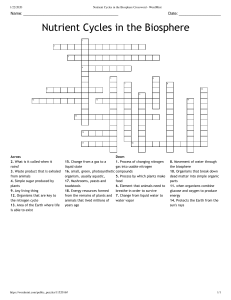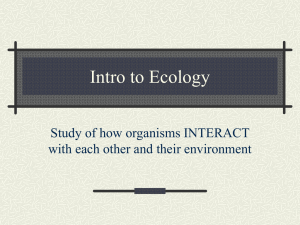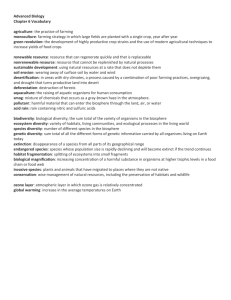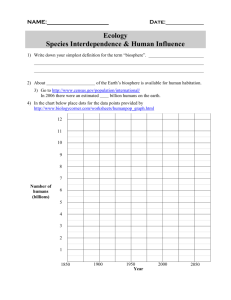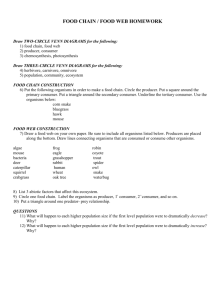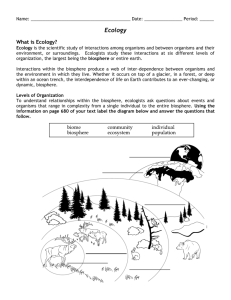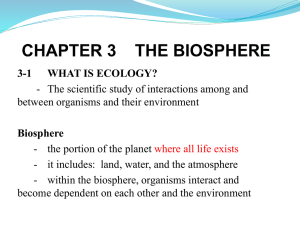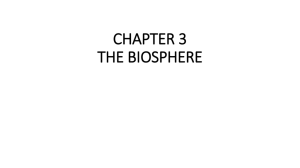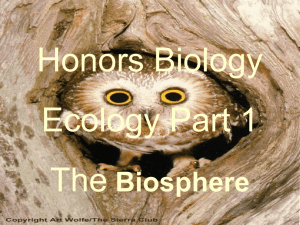Tri 1 Biology Ch 3 Test and Core Questions
advertisement
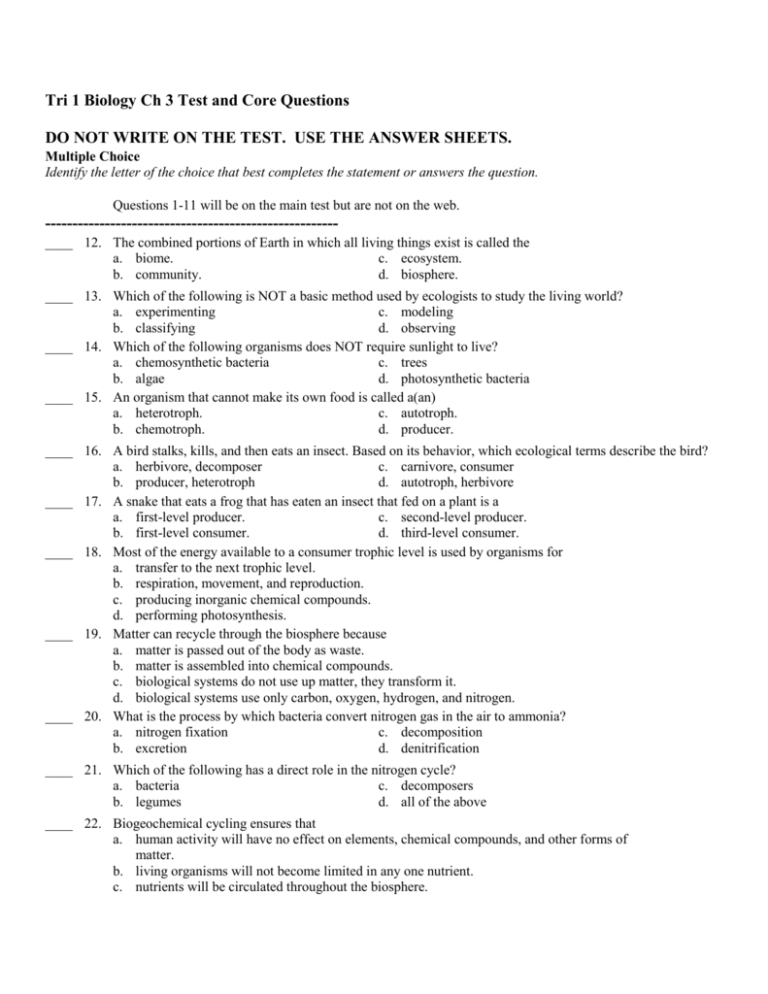
Tri 1 Biology Ch 3 Test and Core Questions DO NOT WRITE ON THE TEST. USE THE ANSWER SHEETS. Multiple Choice Identify the letter of the choice that best completes the statement or answers the question. Questions 1-11 will be on the main test but are not on the web. -----------------------------------------------------____ 12. The combined portions of Earth in which all living things exist is called the a. biome. c. ecosystem. b. community. d. biosphere. ____ 13. Which of the following is NOT a basic method used by ecologists to study the living world? a. experimenting c. modeling b. classifying d. observing ____ 14. Which of the following organisms does NOT require sunlight to live? a. chemosynthetic bacteria c. trees b. algae d. photosynthetic bacteria ____ 15. An organism that cannot make its own food is called a(an) a. heterotroph. c. autotroph. b. chemotroph. d. producer. ____ 16. A bird stalks, kills, and then eats an insect. Based on its behavior, which ecological terms describe the bird? a. herbivore, decomposer c. carnivore, consumer b. producer, heterotroph d. autotroph, herbivore ____ 17. A snake that eats a frog that has eaten an insect that fed on a plant is a a. first-level producer. c. second-level producer. b. first-level consumer. d. third-level consumer. ____ 18. Most of the energy available to a consumer trophic level is used by organisms for a. transfer to the next trophic level. b. respiration, movement, and reproduction. c. producing inorganic chemical compounds. d. performing photosynthesis. ____ 19. Matter can recycle through the biosphere because a. matter is passed out of the body as waste. b. matter is assembled into chemical compounds. c. biological systems do not use up matter, they transform it. d. biological systems use only carbon, oxygen, hydrogen, and nitrogen. ____ 20. What is the process by which bacteria convert nitrogen gas in the air to ammonia? a. nitrogen fixation c. decomposition b. excretion d. denitrification ____ 21. Which of the following has a direct role in the nitrogen cycle? a. bacteria c. decomposers b. legumes d. all of the above ____ 22. Biogeochemical cycling ensures that a. human activity will have no effect on elements, chemical compounds, and other forms of matter. b. living organisms will not become limited in any one nutrient. c. nutrients will be circulated throughout the biosphere. d. many nutrients will not reach toxic concentrations in the biosphere. ____ 23. If a nutrient is in such short supply in an ecosystem that it affects an animal’s growth, the a. animal becomes a decomposer. c. nutrient leaves the food chain. b. substance is a limiting nutrient. d. ecosystem will not survive. Completion Complete each sentence or statement. A picture of a food chain goes here. It will have algae, zooplankton, small fish, squid, shark in it Figure 3–1 24. Of the organisms represented in Figure 3–1, the organisms in the oceans with the smallest total biomass are most likely the ____________________. 25. The organisms in the greatest numbers in Figure 3–1 are the ____________________. 26. In a four-level energy pyramid, if the first level contains 500 calories of energy, the third level will contain approximately ____________________ calories. Below are a series of essay questions. Read each of these carefully and ask yourself. What am I to do? Am I to draw, or list, or explain, or give an example? None of the essays are real short. So check to make sure they are complete. .Research the answer and write it out at home. Work as a group, check each other. Practice writing the essay. 1. Draw a properly written Food Web (as seen in class) of your choice. Include at least 12 different organisms and all trophic levels, properly labeled. 2. Explain, “All things, living and non-living are interconnected” using your food web above. But, do not use the names of the organisms in your explanation. Use other terms. 3. Explain how “All things, living and non-living are interconnected” using the concepts of recycling and non-recycling in natural systems. (Not the same thing as your garbage at home.) 4. List the four principals of ecology as given in the movie “Barry Commoner’s Ecology” seen in class. 5. Explain any one of them in detail. Explaining is not the same thing as giving an example. Explain it.
